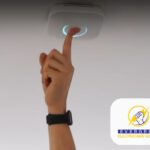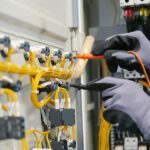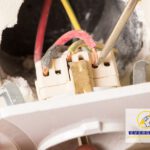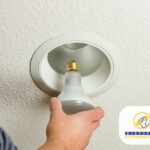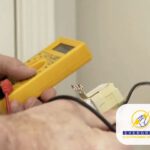Are you fed up with being left in the dark when it comes to common electrical issues in the UK? Fear not – we have the solutions you need to shed some light on the matter.
In this article, we’ll give you an insight into the most frequent electrical hiccups you may encounter in the UK and how to troubleshoot them like a pro.
From flickering lights that make you feel like you’re in a horror movie, to tripped circuit breakers that plunge your home into darkness – we’ve got it covered.
Power cuts, faulty switches, electrical shocks and overloaded circuits will no longer be a mystery. By following our step-by-step guide, you’ll be able to diagnose and resolve these issues with ease, ensuring a safe and efficient electrical system in your home.
So, get ready to become the master of your electrical domain. Let’s dive in and spark some innovation in troubleshooting those common electrical issues in the UK!
Flickering Lights
Are your lights flickering madly? Don’t worry, we’ve got you sorted with some simple troubleshooting tips.
Flickering lights can show various electrical problems, but the most common cause is dimming bulbs or voltage fluctuations. Dimming bulbs occur when the electrical current supplied to the bulb is not consistent, resulting in a fluctuation in brightness. Voltage fluctuations, meanwhile, can be due to external factors such as power surges or faulty wiring.
To troubleshoot flickering lights, start by checking the bulbs to make sure they’re secure and correctly fitted. If the issue remains, it might be worth getting in touch with an electrician to inspect the voltage and wiring in your home.
Right, let’s move on to the next section about tripped circuit breakers.
Tripped Circuit Breakers
When your circuit breakers trip, it’s like a thunderstorm interrupting the flow of electricity in your home, forcing you to reset them to restore power.
Resetting tripped breakers is a simple task that anyone with basic electrical knowledge can do. Find the tripped breaker in your electrical panel, usually indicated by a switch in the opposite position of the others. Switch it off then back on to reset it.
It’s essential to find the cause of the tripped breakers to stop them from occurring again. Common causes include overloaded circuits, short circuits, or ground faults. If the problem continues, it might need an electrician to look into it further.
Before moving onto the next section about power outages, it’s important to note that tripped breakers are different from full power outages caused by external factors.
Power Outages
During a power cut, you’ll need to rely on alternative sources of light and heat. Here are four important things to know:
- Voltage fluctuations: Power cuts can be caused by voltage fluctuations in the electrical grid. These could be due to lightning strikes, equipment faults, or power surges. Protect your electrical devices with surge protectors.
- Emergency backup power: Invest in an emergency backup power system like a generator or battery backup. These systems can kick in automatically when the power goes out, so essential appliances and devices keep running.
- Alternative lighting: Keep alternative lighting sources like torches, lanterns, or candles accessible in case of an emergency.
- Heating solutions: Without power, your heating system may not work. Have alternative heating solutions like a fireplace, a portable heater, or warm blankets handy.
By understanding these points, you can be better prepared for any unexpected power cuts.
In the next section, we’ll look at faulty switches and how to troubleshoot them.
Faulty Switches
To troubleshoot faulty switches, there are two points that should be considered. Firstly, check that all connections are securely fitted to prevent any loose ones. Loose connections can cause switches to malfunction or be unresponsive.
Secondly, if a switch is damaged or not working, it’s important to replace it with a new one to ensure the electrical system is safe and reliable.
Tighten Loose Connections
Secure your electrical system by giving those loose connections a good tightening. Proper earthing is key to ensure the safety and stability of your system. Loose connections can cause voltage fluctuations, potentially damaging appliances and posing a fire hazard.
To tighten them, follow these steps:
- Turn off the power supply to the affected circuit.
- Remove the outlet or switch cover plate with a screwdriver.
- Inspect the wiring and identify any loose wires.
- Firmly tighten the loose connections with a pair of pliers.
- Replace the cover plate and restore power to the circuit.
Tightening loose connections helps prevent electrical problems and ensures a reliable power supply. If you find damaged switches that can’t be repaired, replace them promptly to maintain the safety and functionality of your electrical system.
Replace Damaged Switches
Replacing damaged switches is a quick and easy way to ensure the safety and functionality of your electrical system, so don’t hesitate to swap them out when necessary.
To begin, turn off the power supply to the switch at the consumer unit. Use a voltage tester to confirm that there isn’t any electricity flowing to the switch.
Next, remove the switch cover and unscrew the screws holding the switch in place. Disconnect the wires from the old switch and connect them to the new switch, making sure they are placed correctly.
Tighten the screws to secure the new switch in place. Replace the switch cover and turn the power supply back on. Remember to always follow safety precautions when working with electricity to avoid accidents.
Now, let’s move on to the next section about electrical shocks.
Electrical Shocks
Watch out for electric shocks! They can zap you like a sudden bolt of lightning, leaving you jolted and startled. Electric shocks occur when you come into contact with an electric current. This can happen due to faulty wiring, damaged appliances, or improper use of electrical equipment.
To avoid electric shocks, make sure your electrical system is correctly earthed and fit ground fault circuit interrupters (GFCIs) in areas with water, such as bathrooms and kitchens. Furthermore, don’t use electrical equipment with wet hands and always unplug appliances before touching them.
Check your electrical system regularly for any signs of damage or wear, and if you spot any issues, call a qualified electrician to fix them. Electric shocks can be dangerous, so it’s important to take precautions to protect yourself.
Now, let’s move on to the next section about overloaded circuits.
Overloaded Circuits
To avoid potential hazards, it’s essential to be aware of the capacity of your electrical circuits. Overloading them can have serious repercussions. Connecting too many appliances or devices to a single circuit can cause it to exceed its limit, leading to the circuit breaker tripping or even starting a fire.
To prevent overloading, ensure to spread the electrical load evenly across different circuits. Regular circuit breaker maintenance is also vital to guarantee they’re working correctly. Look out for signs of wear or damage and replace them if necessary.
If you’re often confronted with overloaded circuits, it may be time to consider electrical panel upgrades. Upgrading your electrical panel can boost its capacity and stop future issues.
Frequently Asked Questions
What are the potential causes of flickering lights in a UK home?
The potential causes of flickering lights in a UK home can be attributed to various factors. Common causes for power outages include faulty wiring, loose connections, or overloaded circuits. To address this, check the electrical panel for tripped breakers, inspect light fittings for loose bulbs or connections, and ensure the electrical load is spread evenly across circuits. Consulting a qualified electrician can help provide solutions to these flickering light problems.
How can I determine if a circuit breaker has tripped and how do I reset it?
To determine if a circuit breaker has tripped, use your deductive powers! Look for any lights or appliances that’ve suddenly stopped working. If so, it’s time to troubleshoot the circuit breaker. Locate the breaker panel and scan for any switches in the ‘off’ position. Push the switch firmly to the ‘on’ position to reset it. Voila! You’ve solved the issue with your circuit breaker troubleshooting skills!
Are power outages in the UK usually caused by issues within the home’s electrical system, or are they typically due to wider power grid problems?
In the UK, power outages are usually caused by wider power grid problems rather than issues within the home’s electrical system. These outages can be due to severe weather, equipment failure, or maintenance work.
Power grid issues can affect multiple households and even entire areas. To find out if the power outage is due to a wider grid issue, it’s advisable to contact the local electricity distribution company for updates and information.
What are the signs of a faulty switch, and how can I fix it myself?
If you’re experiencing a faulty switch, there are a few signs to look out for. Is it not turning on or off as it should? Does it make strange noises or feel loose?
To troubleshoot, start by checking the circuit breaker and ensuring the switch is properly connected. If that doesn’t work, you may need to replace the switch. Remember to switch off the power before attempting any repairs.
With these troubleshooting techniques, you can fix common switch problems yourself.
What should I do if I experience an electrical shock in my home, and what are the potential dangers associated with it?
If you experience an electrical shock in your home, it’s essential to prioritize your safety. Electrical shock dangers can be severe, including burns, cardiac arrest, and even death. To ensure your safety, take immediate action by disconnecting the power source, if possible, and seek medical attention straight away.
Avoid touching the person experiencing the shock directly to prevent further injuries. Always follow safety precautions when dealing with electricity and consult a professional for any electrical issues.


